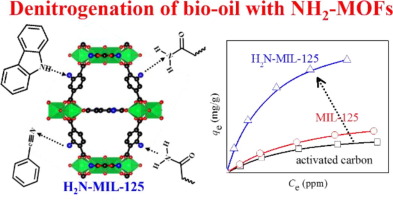Chemical Engineering Journal ( IF 15.1 ) Pub Date : 2020-01-23 , DOI: 10.1016/j.cej.2020.124195 Biswa Nath Bhadra , Sung Hwa Jhung

|
Microalgae-derived bio-oils have recently attracted interest as a potential alternative to traditional transportation fuels. However, the wide variety organo-nitrogen compounds (ONCs) in such bio-oils are detrimental not only to the environment but also to fuel processing equipment. Removal of these ONCs from bio-oils prior to the oil being burnt is particularly important. Therefore, we investigated the adsorptive removal of carbazole (CBZ), hexadecanamide (HDA), and benzonitrile (PhCN), which are present in bio-oil and are difficult to remove via conventional methods, using metal–organic frameworks (MOFs) for the first time. We employed two widely studied MOFs with or without an amino (–NH2) functionality (MIL-125, H2N–MIL-125, UiO-66, and H2N–UiO-66). These MOFs were found to be more efficient adsorbents than a conventional adsorbent, activated carbon. In particular, among the tested adsorbents, the –NH2 functionalized MOFs, especially H2N–MIL-125, exhibited the highest adsorption capacities. The role of the –NH2 functionality was explained on the basis of H-bonding interactions, which were the main driving force for enhanced ONC capture. The used H2N–MIL-125 could be recycled via simple solvent washing. On the basis of the remarkably high efficiency of H2N–MIL-125 in adsorptive denitrogenation (e.g., this MOF had 3.3, 11.2 and 15.2 times adsorption capacity for CBZ, HDA and PhCN, to that of AC, respectively) and its easy regeneration, the H2N–MIL-125 is proposed as a prospective adsorbent for the purification of algae-derived bio-oil.
中文翻译:

使用带氨基的金属有机骨架从微藻类生物油中吸附去除含氮化合物
微藻衍生的生物油作为传统运输燃料的潜在替代品最近引起了人们的兴趣。但是,这种生物油中的各种有机氮化合物(ONC)不仅有害于环境,而且有害于燃料处理设备。在生物油燃烧之前,从生物油中去除这些ONC尤为重要。因此,我们研究了生物油中存在的咔唑(CBZ),六癸酰胺(HDA)和苄腈(PhCN)的吸附去除,使用金属有机骨架(MOF)进行常规方法难以去除。第一次。我们采用了两种广泛研究的具有或不具有氨基(–NH 2)官能度的MOF (MIL-125,H 2 N–MIL-125,UiO-66和H 2N–UiO-66)。发现这些MOF比常规的吸附剂活性炭更有效。特别是,在测试的吸附剂中,–NH 2官能化的MOF,尤其是H 2 N–MIL-125,表现出最高的吸附能力。在氢键相互作用的基础上解释了–NH 2功能的作用,这是增强ONC捕获的主要驱动力。使用过的H 2 N–MIL-125可以通过简单的溶剂洗涤回收利用。基于H 2 N–MIL-125在吸附脱氮方面的显着高效率(例如,该MOF对CBZ,HDA和PhCN的吸附能力分别是对AC的3.3、11.2和15.2倍),并且其易操作性再生,H建议使用2 N–MIL-125作为纯化藻类生物油的潜在吸附剂。



























 京公网安备 11010802027423号
京公网安备 11010802027423号